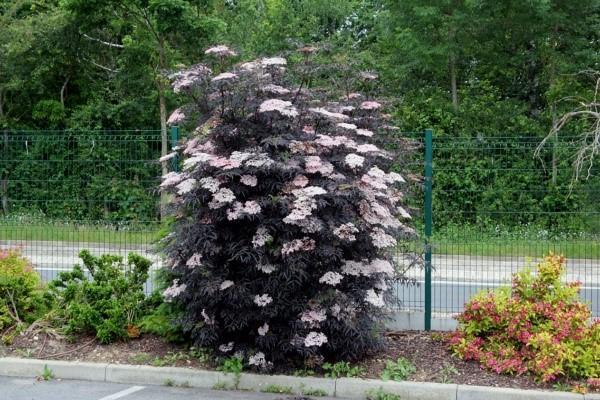Black Elderberry Black Lace: highly decorative and frost-resistant variety for your garden
 Due to its gorgeous flowering and spectacular appearance of lush bushes, elderberry is often planted in private plots, but in winter it often suffers from frost. However, there is one species among its varieties that is not afraid of severe frosts - this is the black elderberry Black Lace. Increased winter hardiness and beautiful cherry-black leaves make the culture a welcome guest in every garden. What is so special about this variety and is it difficult to grow it?
Due to its gorgeous flowering and spectacular appearance of lush bushes, elderberry is often planted in private plots, but in winter it often suffers from frost. However, there is one species among its varieties that is not afraid of severe frosts - this is the black elderberry Black Lace. Increased winter hardiness and beautiful cherry-black leaves make the culture a welcome guest in every garden. What is so special about this variety and is it difficult to grow it?
Description of the variety
Elderberry grows in the form of a wide shrub up to 2 m in height with the same crown diameter. The shape and structure of the Black Lace leaves is fully consistent with its name, which translates as "black lace". Indeed, large leaf plates are dissected into thin long lobes, resembling a lace pattern. And they are painted in a dark cherry, almost black color with a glossy sheen, giving the elderberry bush a special decorative effect.
Dark-leaved varieties are best planted in the foreground, rather than used for the background. Such types of elderberry are well combined in group plantings with conifers, spirea, barberry.
The bush blooms with small pinkish flowers, collected in dense cluster inflorescences. As it fades, the pink tint changes to cream. What is also characteristic - they smell amazing, spreading a delicate scent of lemon. In early autumn, fruits ripen, red-black berries. They are edible and suitable for making compote or jam.
The only drawback of the variety is its low resistance to aphid infestation.
Black elderberry Black Lace: cultivation features
The shrub has a rather unpretentious character and can grow in partial shade. But in order for its varietal characteristics to manifest, it is better to plant an elder in a well-lit place. Then the leaves will have a characteristic dark color. In a shaded corner, they will just turn dark green.
Elderberry has no special requirements for soil. She will survive in poor, sandy and even limestone soil. But it is still advisable to pre-fertilize the site so that the bush can develop more actively.
Caring for the black elderberry Black Lace will not cause much trouble:
- In the hot summer, you need to water the bush regularly.
- It is advisable to mulch the trunk circle so that the moisture persists longer.
- Once a year, in spring, it should be fed with nitrogen-containing mineral fertilizers and humus.
- It is worth pruning from time to time to give the crown a neat look. Otherwise, the bush will grow strongly and may become a weed.
- Treat to prevent the appearance of aphids.
The variety can be propagated by seeds, cuttings and layering.